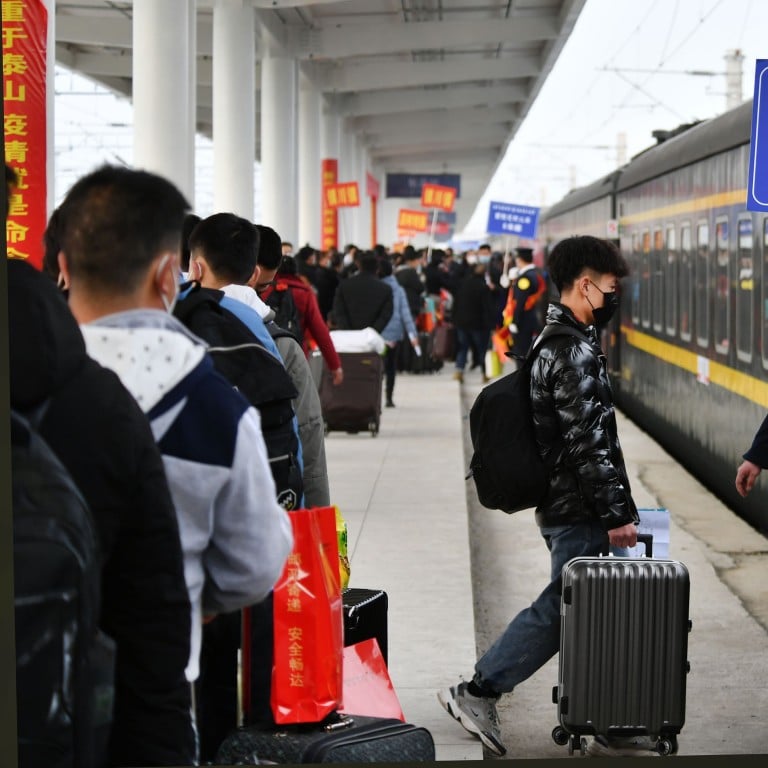
Coronavirus: China’s workers leave lockdown only to be trapped by prejudice and red tape
- The outbreak’s initial epicentre of Hubei relaxes its restrictions, but those returning to other parts of the country find some doors remain closed
- Citizens encounter barriers to resuming work, such as being refused permission to travel and difficulty obtaining documents to prove their health
China’s efforts to get people back to work are being hampered by a labyrinth of quarantine measures that remain in place even as some local authorities try to ease restrictions.
Only carriers of a green colour code, indicating that they were healthy, were allowed to enter a city.
Eager for people to resume work, the government of Hubei province – where the coronavirus was first reported late last year – on Thursday ordered local officials and quarantine enforcers to accept the digital health code issued by cities elsewhere without demanding other proof of health.
But some residents have reported being turned away despite having a green label, because of a lack of universal recognition of the system.
“Every city has a different set of rules,” a 36-year-old businessman in Hubei said on Thursday. “My city has not had new cases for nearly 20 days. But other provinces don’t care about that.”
The man, who gave his name only as Andy, is one of the millions of Chinese workers who travelled to their hometown before the Lunar New Year in January to spend the holiday with their family.
Their experiences highlight the tightrope that the Chinese authorities have been walking between resuscitating a battered economy and preventing infection numbers rising again after travel restrictions are eased.
Since late January, public transport countrywide has been disrupted, mobile phone data has been used to track people’s movements, and community workers have been mobilised to enforce city lockdowns and home quarantines.
These measures meant that Andy was confined to his home with his parents in Hubei for more than 40 days.
Hubei residents defy lockdown to protest against overpriced food
People from Hubei continue to face further obstacles even with the province having reported few new cases in the past week.
Some have said that after travelling out of Hubei, they have been forced to pay to stay in quarantine facilities despite having no respiratory symptoms or contact with coronavirus patients.
Andy said he was having trouble collecting all of the health documents required for him to be allowed to travel home to the eastern city of Ningbo.
His cousin, who works in the southern metropolis of Shenzhen, will have to pay to stay in quarantine for 14 days on arrival there, he said.
On social media, many people have complained of being barred from travelling because they could not obtain all the documents and stamps needed to prove their health.
“I can’t receive a full salary. I have to pay rent. And I have to pay 160 yuan (US$23) a day to live in quarantine,” one person said on social media platform Weibo on Tuesday. “The word Hubei just means virus.”
Another person posted on Wednesday evening that a government-arranged bus from Hubei was banned from entering Shanghai. The post attracted several hundred comments accusing bureaucrats of discriminating against Hubei people.
Are China-style lockdowns the answer to containing the coronavirus?
At a press conference on Wednesday, Hubei’s deputy provincial governor Cao Guangjing acknowledged that many people were struggling to travel to where they worked as a consequence of the bureaucratic hurdles.
“I earnestly request our fellow provinces and cities to provide care and support to workers from low-risk areas in Hubei,” Cao said.
The shutdown of factories, shops and restaurants over the past two months has dealt a blow to the world’s second-biggest economy, with several key industrial and retail growth indicators dropping to all-time lows in January and February.
Some economists have predicted a contraction in the first quarter, which would be the first reversal of China’s growth after more than four decades of non-stop expansion.
Purchase the China AI Report 2020 brought to you by SCMP Research and enjoy a 20% discount (original price US$400). This 60-page all new intelligence report gives you first-hand insights and analysis into the latest industry developments and intelligence about China AI. Get exclusive access to our webinars for continuous learning, and interact with China AI executives in live Q&A. Offer valid until 31 March 2020.

